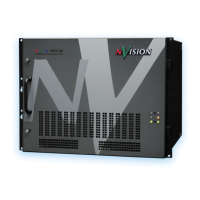44 Rev 2.3 • 14 Oct 08
3. Installation
Installing Active Cards
2 Facing the rear of the router, remove any blank plate covering the desired slot by loosening the
spring-loaded module retention screws using a #1 Phillips screwdriver. Gripping the screws,
gently pull the blank plate free from the frame, using a slight rocking motion if needed. Use
caution to avoid damaging connector pins.
Or
If reconfiguring the router, relocate backplanes as needed.
3 Insert the new backplane into the frame being sure to align the printed circuit board with the
stamped guides in the frame. Use gentle pressure at the top of the backplane to ensure the back-
plane connector is fully mated with the motherboard.
4 Use a #1 Phillips screwdriver to tighten the two spring-loaded backplane retention screws.
5 To maintain proper airflow for cooling, cover any unused backplane slots with a blank plate.
Installing Active Cards
The NV5128 router features several active cards that manage incoming signals, forward control
system commands, perform signal switching and distribute outgoing signals. Cards slide into a card
guide such that the connectors on the rear of the card interface with the motherboard. Each card has
two levers—one at the top and one at the bottom—that help eject the card for easy removal. For a
description of each card, see Active Cards
on page 21. Cards are held in place by pressure from the
closed router door against the metal plate on the front of each card. All cards can be inserted and
removed with the power on.
There are many possible ways to populate the NV5128 frame with active cards. Before installing
any cards, make sure that for each input card and output card being installed in a slot, a correspond-
ing backplane has been installed on the rear for that slot (see Installing Backplanes
on page 40).
Unlike other active cards, the Classic SWB card set and the Machine Control card set take up two
card slots. Each card set requires two associated backplanes, either for SWB or Machine Control
signals. For a description of each card, see Active Cards
on page 21. For a description of associated
backplanes, see Backplanes
on page 13.
Legend strips attached to the frame identify card locations. Output cards occupy the outer four slots
on either side of the frame, while input cards are located in the center eight slots. (See Figure 2-3 on
page 11.)
Systems Clock Generator Card
If only one control card is being installed, an optional Systems Clock Generator card may be
installed to ensure system clock backup. See Systems Clock Generator Card
on page 22.
Note Before placing the router into service, be sure to verify the quantity and loca-
tion of each backplane. Each backplane must have a corresponding input card
and output card.

